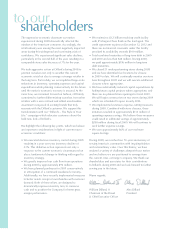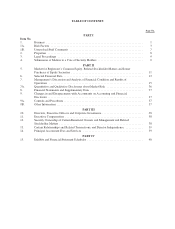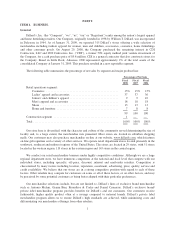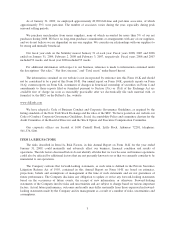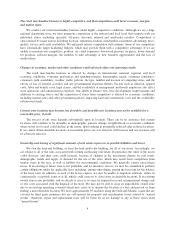Dillard's 2008 Annual Report Download - page 10
Download and view the complete annual report
Please find page 10 of the 2008 Dillard's annual report below. You can navigate through the pages in the report by either clicking on the pages listed below, or by using the keyword search tool below to find specific information within the annual report.The retail merchandise business is highly competitive, and that competition could lower revenues, margins
and market share.
We conduct our retail merchandise business under highly competitive conditions. Although we are a large
regional department store, we have numerous competitors at the national and local level that compete with our
individual stores, including specialty, off-price, discount, internet and mail-order retailers. Competition is
characterized by many factors including location, reputation, fashion, merchandise assortment, advertising, price,
quality, service and credit availability. We anticipate intense competition will continue. Some of our competitors
have substantially larger marketing budgets, which may provide them with a competitive advantage. If we are
unable to maintain our competitive position, we could experience downward pressure on prices, lower demand
for products, reduced margins, the inability to take advantage of new business opportunities and the loss of
market share.
Changes in economic, market and other conditions could adversely affect our operating results.
The retail merchandise business is affected by changes in international, national, regional, and local
economic conditions, consumer preferences and spending patterns, demographic trends, consumer confidence,
consumer credit availability, weather, traffic patterns, the type, number and location of competing stores, and the
effects of war or terrorist activities and any governmental responses thereto. Factors such as inflation, apparel
costs, labor and benefit costs, legal claims, and the availability of management and hourly employees also affect
store operations and administrative expenses. Our ability to finance new store development, improvements and
additions to existing stores, and the acquisition of stores from competitors is affected by economic conditions,
including interest rates and other government policies impacting land and construction costs and the availability
of borrowed funds.
Current store locations may become less desirable, and desirable new locations may not be available for a
reasonable price, if at all.
The success of any store depends substantially upon its location. There can be no assurance that current
locations will continue to be desirable as demographic patterns change. Neighborhood or economic conditions
where stores are located could decline in the future, thus resulting in potentially reduced sales in those locations.
If we cannot obtain desirable locations at reasonable prices our cost structure will increase and our revenues will
be adversely affected.
Ownership and leasing of significant amounts of real estate exposes us to possible liabilities and losses.
We own the land and building, or lease the land and/or the building, for all of our stores. Accordingly, we
are subject to all of the risks associated with owning and leasing real estate. In particular, the value of the assets
could decrease, and their costs could increase, because of changes in the investment climate for real estate,
demographic trends and supply or demand for the use of the store, which may result from competition from
similar stores in the area, as well as liability for environmental conditions. We generally cannot cancel these
leases. If an existing or future store is not profitable, and we decide to close it, we may be committed to perform
certain obligations under the applicable lease including, among other things, paying the base rent for the balance
of the lease term. In addition, as each of the leases expires, we may be unable to negotiate renewals, either on
commercially acceptable terms or at all, which could cause us to close stores in desirable locations. If an existing
owned store is not profitable, and we decide to close it, we may be required to record an impairment charge and/
or exit costs associated with the disposal of the store. We may not be able to close an unprofitable owned store
due to an existing operating covenant which may cause us to operate the location at a loss and prevent us from
finding a more desirable location. We have approximately 95 facilities along the Gulf and Atlantic coasts that are
covered by third party insurance but are self-insured for property and merchandise losses related to “named
storms”; therefore, repair and replacement costs will be borne by us for damage to any of these stores from
“named storms”.
4


